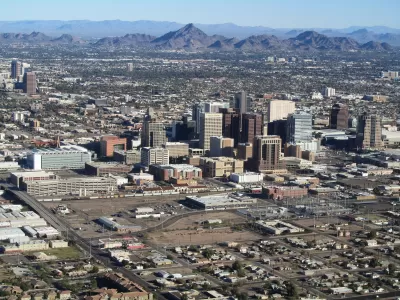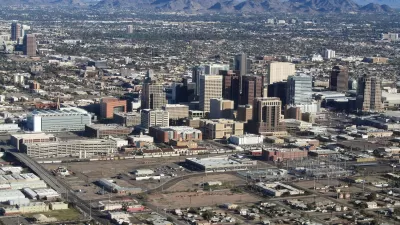Pipeline breaks are a daily occurrence in the city, but funding for an expanded pipe-replacement program has been a contentious issue.

Jessica Boehm reports that Phoenix is at a crossroads in dealing with its aging waterline infrastructure. The city has 7,000 waterlines, many of which will need to be replaced now or in coming decades. The city deals with 4,000 waterline breaks annually that cause street closures and traffic problems and waste large quantities of water.
But, the city does not have the funds needed to expand its pipe-replacement program. The city council recently voted to increase the water rate by 6 percent this year and again next year in order to raise $500 million to replace pipes as well as build new wells to access groundwater.
The city council was split. Opponents say low-income residents are going to be unfairly burdened by the rate hike and funding needs to come from other sources. But supporters argue that Phoenix has to be proactive about upgrading its water infrastructure or it will face a water supply crisis in the future.
FULL STORY: Phoenix has 4,000 waterline breaks per year. Will water-rate hike solve the problem?

Alabama: Trump Terminates Settlements for Black Communities Harmed By Raw Sewage
Trump deemed the landmark civil rights agreement “illegal DEI and environmental justice policy.”

Study: Maui’s Plan to Convert Vacation Rentals to Long-Term Housing Could Cause Nearly $1 Billion Economic Loss
The plan would reduce visitor accommodation by 25% resulting in 1,900 jobs lost.

Why Should We Subsidize Public Transportation?
Many public transit agencies face financial stress due to rising costs, declining fare revenue, and declining subsidies. Transit advocates must provide a strong business case for increasing public transit funding.

Paris Bike Boom Leads to Steep Drop in Air Pollution
The French city’s air quality has improved dramatically in the past 20 years, coinciding with a growth in cycling.

Why Housing Costs More to Build in California Than in Texas
Hard costs like labor and materials combined with ‘soft’ costs such as permitting make building in the San Francisco Bay Area almost three times as costly as in Texas cities.

San Diego County Sees a Rise in Urban Coyotes
San Diego County experiences a rise in urban coyotes, as sightings become prevalent throughout its urban neighbourhoods and surrounding areas.
Urban Design for Planners 1: Software Tools
This six-course series explores essential urban design concepts using open source software and equips planners with the tools they need to participate fully in the urban design process.
Planning for Universal Design
Learn the tools for implementing Universal Design in planning regulations.
Smith Gee Studio
Alamo Area Metropolitan Planning Organization
City of Santa Clarita
Institute for Housing and Urban Development Studies (IHS)
City of Grandview
Harvard GSD Executive Education
Toledo-Lucas County Plan Commissions
Salt Lake City
NYU Wagner Graduate School of Public Service





























